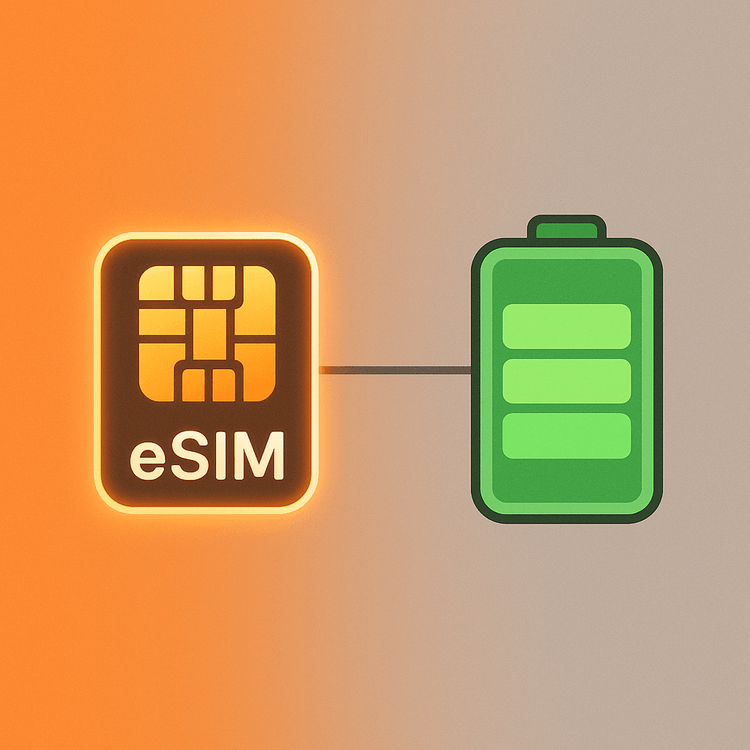テクノロジーに詳しい旅行者にとって、これはよくある質問です。eSIMの利便性にワクワクする一方で、ホテルに着く前にスマホの電源が切れてしまうのではないかと心配になります。Yoho MobileのeSIMに切り替えることは、バッテリー寿命を犠牲にすることを意味するのでしょうか?はっきりさせましょう。
結論から言うと、いいえ、そんなことはありません。eSIM自体が物理SIMカードより本質的に多くの電力を消費することはありません。どちらも、スマホがモバイルネットワークに対して自身を安全に識別するための方法に過ぎないのです。バッテリー寿命に関する本当の議論は、デュアルSIMとして知られる設定、つまり2つのSIMを同時に使用する場合に始まります。
バッテリーの心配なく、シームレスなグローバル接続を体験する準備はできましたか?今すぐYoho Mobileの柔軟なeSIMプランをお試しください そして、冒険中も充電切れの心配なく過ごしましょう。

本当の原因:デュアルSIMでバッテリー寿命に実際に影響を与えるものとは?
スマホが2つの回線(例えば、自国のSIMと旅行用のeSIM)を同時に実行しているとき、2つの別々のネットワーク接続を管理しています。これが余分なバッテリー使用の可能性が生まれる点ですが、eSIMのせいではありません。バッテリーへの影響は、SIMのテクノロジー自体ではなく、いくつかの要因によって決まります。
ラジオを1つではなく2つつけているようなものだと考えてください。重要なのは、スマホがそれらをどれだけ効率的に管理できるかです。本当に重要なのは以下の点です。
- 電波強度: これが最大の要因です。メインのSIMまたはYoho Mobile eSIMのどちらかが電波の弱いエリアにある場合、スマホのモデムは接続を見つけて維持するために過剰に動作しなければなりません。この絶え間ない検索が、バッテリーを大幅に消耗させます。Yoho Mobileが提携する高品質なネットワークパートナーを通じて提供する、強力で安定した接続は、電波の弱いローミング物理SIMよりも実際にバッテリー寿命を延ばすことさえあります。
- ネットワーク技術(5G vs. 4G/LTE): 5Gは非常に高速ですが、特に5Gネットワークが完全に確立されていないエリアでは、4G/LTEよりも多くの電力を消費する可能性があります。スマホが頻繁にネットワークを切り替えることも、エネルギーを消費します。
- バックグラウンドデータ使用量: データ通信を有効にしているeSIMで、多数のアプリがバックグラウンドで更新、同期、プッシュ通知を行っている場合、そのアクティビティはバッテリーを消費します。原因はeSIMではなく、データ使用量です。

Yoho Mobile eSIMでバッテリー寿命を最適化する6つの実用的なヒント
デュアルSIMが実際の使用でバッテリーに与える影響が心配ですか?ご安心ください、すべて自分でコントロールできます。いくつかの簡単な調整で、常に電源コンセントを探すことなくYoho Mobile eSIMのメリットを享受できます。ここでは、eSIMを使ってiPhoneやAndroidのバッテリーを最適化する方法をご紹介します。
1. Yoho eSIMをデータ通信のメイン回線に設定する
日本やスペインなどの新しい国に到着したら、スマホのモバイル通信設定に入り、Yoho Mobileの日本eSIMをモバイルデータ通信専用の回線として指定します。これにより、電波を探している可能性のある自国のSIMからスマホがデータを使用しようとするのを防ぎます。
2. 自国の回線を一時的に無効にする
旅行先で自国のネットワークの電波が非常に弱い、またはまったくない場合、スマホは継続的に接続を探し続け、バッテリーを消耗します。最善の策は、モバイル通信設定に入り、その回線を一時的にオフにすることです。必要なときに簡単にオンに戻せます。
3. 必要に応じて5Gより4G/LTEを選択する
4Kビデオのストリーミングや巨大なファイルのダウンロードをしていない場合は、5Gオートの代わりに手動で4G/LTEを選択することで、バッテリーを大幅に節約できることがよくあります。モバイルデータ通信のオプションで、「音声通話とデータ」を5GからLTEに変更してください。地図、メッセージング、ブラウジングには十分な速度です。
4. Appのバックグラウンド更新を管理する
どのアプリがバックグラウンドで更新を許可されているかを確認します。iOSの場合は「設定」>「一般」>「Appのバックグラウンド更新」、Androidの場合は同等の設定に移動し、重要でないアプリについては無効にするか、Wi-Fiのみに設定します。
5. スマホのeSIM対応状況とOSを確認する
お使いのデバイスが公式のeSIM対応機種リストに載っていること、そしてオペレーティングシステムが最新であることを確認してください。スマホメーカーは、モデムのファームウェア改善やより良いバッテリー管理アルゴリズムを含むアップデートを頻繁にリリースしています。
6. eSIMを簡単にアクティベートする
アクティベートのプロセス自体は電力効率が良いことを覚えておいてください。iOSユーザーにとって、Yoho Mobile eSIMの設定は簡単です—QRコードは不要です。購入後、「インストール」をタップするだけで、1分以内にプロファイルが追加されます。詳細な手順については、iOSインストールガイドをご覧ください。Androidユーザーは、簡単なセットアップガイドに従って、すぐに使い始めることができます。
そして、データを使い切ってしまったらどうしますか?接続が切れる心配はありません。Yoho Careがあれば、オンライン状態を維持するためのセーフティネットがあるので、接続が切れる心配なく最適なバッテリー寿命のためにデータを管理できます。
よくある質問(FAQ)
Q1: Yoho Mobile eSIMのみを使用し、物理SIMを取り外した場合、バッテリーは節約できますか?
はい、その可能性が高いです。単一の回線を使用する(eSIMでも物理SIMでも)ことは、2つを使用するよりも常に電力効率が良いです。海外で自国の電話番号が必要ない場合は、Yoho Mobile eSIMのみを使用するのが素晴らしいバッテリー節約戦略です。
Q2: eSIMでスマホをホットスポットとして使用すると、バッテリーの消耗は早くなりますか?
スマホをホットスポットとして使用することは、eSIMを使用しているか物理SIMを使用しているかに関わらず、電力を大量に消費するタスクです。スマホのモデムとWi-Fi無線を同時に使用します。便利ですが、バッテリーはより速く消耗すると考えてください。充電器にアクセスできるときに使用するのが最適です。
Q3: AndroidとiPhoneでeSIMのバッテリー使用量に違いはありますか?
AndroidとiOSはどちらも成熟したデュアルSIM管理機能を備えています。実際のバッテリーへの影響は、特定のスマホのモデル、そのモデムの効率、およびユーザーの設定によって決まります。どちらのプラットフォームにも本質的な利点はなく、この記事で提供されている最適化のヒントは両方に適用されます。
Q4: どちらのSIMが最もバッテリーを使用しているかを確認するにはどうすればよいですか?
最新のスマートフォンのほとんどは、設定で個々のSIMカードごとのバッテリー使用量を分けて表示しません。「モバイルネットワーク」や「モバイル通信」の使用量を単一のカテゴリとして表示します。最良の指標は電波強度です。電波が弱い(バーの数が少ない)方の回線が、ほぼ間違いなくより多くの消耗を引き起こしています。
結論:妥協のない接続性
eSIMがバッテリーキラーであるという神話は、まさにそれ—神話に過ぎません。テクノロジー自体は、従来のSIMカードと同じくらい電力効率が良いのです。バッテリー消費における本当の要因は、スマホが2つのアクティブなネットワーク回線をどのように管理するかであり、電波強度が最も重要な変数です。
Yoho Mobileのような信頼できるサービスを利用して強力なローカル接続を確保し、私たちの簡単な最適化のヒントを適用することで、コンセントに縛られることなくデュアルSIM旅行のすべての利便性を享受できます。一日中持続する電力で、自分の条件で接続を維持する柔軟性を手に入れることができます。
よりスマートに旅をする準備はできましたか? 200以上の国と地域に対応するYoho Mobileの柔軟でお手頃なeSIMプランをご覧ください そして、あなたの接続性とバッテリー寿命をコントロールしましょう。
